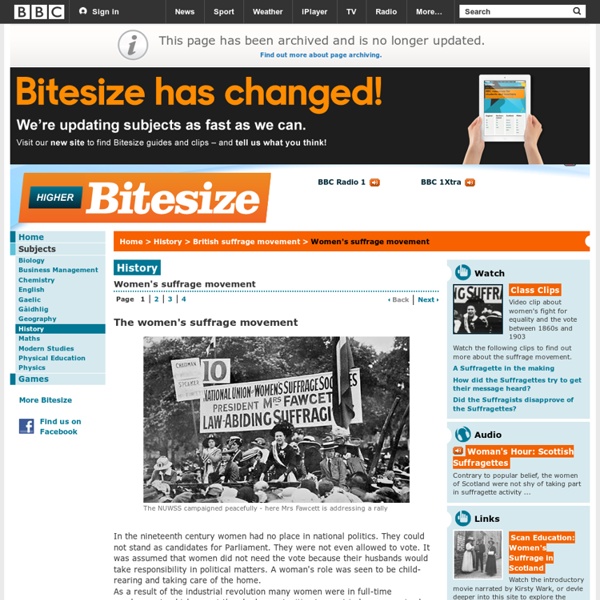



http://www.bbc.co.uk/bitesize/higher/history/britsuff/suffrage/revision/1/
Related: WomenThe Fight to Vote "We hold these truths to be self-evident: that all men are created equal." With those words, the Declaration of Independence set forth the idea of equality. But the women at the Woman's Rights Convention in Seneca Falls, New York, in 1848, felt that a key phrase was missing. Elizabeth Cady Stanton, Lucretia Mott and others rewrote the Declaration. The Suffragettes The Suffragettes wanted the right for women to vote. The move for women to have the vote had really started in 1897 when Millicent Fawcett founded the National Union of Women's Suffrage. "Suffrage" means the right to vote and that is what women wanted - hence its inclusion in Fawcett's title. Millicent Fawcett believed in peaceful protest.
Girls' Education Overview Girls’ education goes beyond getting girls into school. It is also about ensuring that girls learn and feel safe while in school; complete all levels of education with the skills to effectively compete in the labor market; learn the socio-emotional and life skills necessary to navigate and adapt to a changing world; make decisions about their own lives; and contribute to their communities and the world. Girls’ education is a strategic development priority. Better educated women tend to be healthier, participate more in the formal labor market, earn higher incomes, have fewer children, marry at a later age, and enable better health care and education for their children, should they choose to become mothers. All these factors combined can help lift households, communities, and nations out of poverty.
The educational struggle faced by girls around the world Image copyright Reuters Occasionally stories break through that give a graphic sense of the enormous educational struggle faced by children, particularly girls, in many parts of the world. For example, the shooting in the head of Malala Yousafzai - an advocate for girls' education - in 2012; the Taliban murder of 132 schoolchildren in an attack on a school in Peshawar, Pakistan, in 2014; and the abduction by Boko Haram of some 200 Nigerian schoolgirls in the same year. Behind the headlines, the outlook, in terms of educational opportunities for children in some of the poorest parts of the world, appears to be worsening, in spite of international efforts to reverse the trend. Norway's capital, Oslo, played host this week to an education and development conference, led by the Norwegian Prime Minister, Erna Solberg. On the agenda was the issue of what to do about the education of children, particularly girls, worldwide.
Facts about women's rights Violence against women and girls Violence against women and girls is a global issue with 1 in 3 women across the world experiencing violence. (London School of Hygiene & Tropical Medicine, 2013) Statistics show that the abuser is usually someone the woman knows: 38% of all murdered women are killed by their partner. (London School of Hygiene & Tropical Medicine, 2013) Women’s-to-men’s earnings ratio by age, 2009 : The Economics Daily : U.S. Bureau of Labor Statistics Women’s-to-men’s earnings ratio by age, 2009 July 08, 2010 In 2009, women who were full-time wage and salary workers had median weekly earnings that were about 80 percent of the earnings of their male counterparts. In 1979, the first year for which comparable earnings data are available, women earned about 62 percent as much as men.
Women's Rights A look back at history shows that women have made great strides in the fight for equality, including women’s suffrage and inroads in equal opportunity in the workplace and education. Despite the tremendous progress made in the struggle for gender equality, women still face violence, discrimination, and institutional barriers to equal participation in society. Through litigation, advocacy, and public education, the ACLU Women’s Rights Project pushes for change and systemic reform in institutions that perpetuate discrimination against women, focusing its work in the areas of employment, violence against women, and education.
Indian worker left to die on Nokia assembly line By Arun Kumar 9 November 2010 On October 31, a young female worker was left to die on the assembly line at the Nokia factory in southern India after her head and neck got trapped and crushed inside a robotic loading machine. The horrifying incident exposed conditions that prevail in most of the country’s factories, where human life and limb are subordinated to the drive to reap profits off of cheap labor. Higher Bitesize History - Why women got the vote : Revision